| Columns Retired Columns & Blogs |
Bel Canto e.One DAC3.5VB D/A converter Measurements
Sidebar 3: Measurements
I used Stereophile's loan sample of the top-of-the-line Audio Precision SYS2722 system to perform the measurements on the Bel Canto e.One DAC3.5VB (see www.ap.com and the January 2008 "As We See It"); for some tests, I also used my vintage Audio Precision System One Dual Domain and the Miller Audio Research Jitter Analyzer. For these tests, the DAC3.5VB was powered by Bel Canto's e.One VBS1 12V DC supply.
The DAC3.5VB successfully locked on to datastreams with sample rates of up to 192kHz. The volume control operated in accurate 0.5dB steps. The Bel Canto's maximum output level at 1kHz was 5.32V balanced and 2.66V unbalanced (the latter is 2.5dB higher than the CD standard's 2V RMS), and was sourced from output impedances of 199.5 and 100 ohms, respectively, at all frequencies. Both outputs preserved absolute polarity (ie, were non-inverting), with the XLR jacks wired with pin 2 hot.
The frequency response was flat within the audioband (fig.1), and was not affected by the loading down of the output to 600 ohms. The response shape followed the same gentle rolloff above the audioband, disturbed only by the sharp drop-off just below half the sample rate with 44.1kHz sampling (blue and red traces) and 96kHz sampling (cyan and magenta). With 192kHz data (green and gray), the response was down 3dB at 75kHz. Note, however, the 0.2dB channel imbalance in this graph. While this will not be audible, I was surprised to see it at all. Channel separation was superb, with any crosstalk below –125dB in the midrange (fig.2).

Fig.1 Bel Canto DAC3.5VB, frequency response at –12dBFS into 100k ohms from balanced outputs with data sampled at: 44.1kHz (left channel blue, right red), 96kHz (left cyan, right magenta), 192kHz (left green, right gray). (0.25dB/vertical div.)
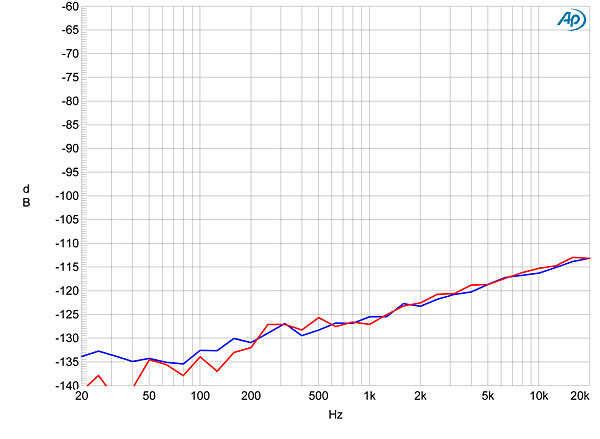
Fig.2 Bel Canto DAC3.5VB, balanced channel separation (R–L blue, L–R red; 10dB/vertical div.).
The original DAC3, which I reviewed in November 2007, was a resolution champ (see http://tinyurl.com/45ckkuh); the DAC3.5VB was just as good. The top pair of traces in fig.3 shows the spectrum of the Bel Canto's output, produced by sweeping a 1/3-octave bandpass filter from 20kHz to 20Hz while the processor decoded dithered 16-bit data representing a 1kHz tone at –90dBFS. The trace is dominated by the recorded dither noise. Increasing the word length to 24 bits gave the middle pair of traces in fig.3; the noise floor has dropped by up to 24dB, implying a resolution of at least 20 bits, which is easily enough to allow the DAC3.5 to reproduce a dithered 24-bit tone at –120dBFS (bottom traces). Peculiarly, repeating this analysis with an FFT technique didn't give as big a drop in the noise floor (fig.4). Perhaps some ultrasonic noise was folding down into the audioband. However, when I repeated the test using either the SYS2722's internal 20kHz "brickwall" low-pass filter or an external 6th-order low-pass filter, I got the same result.

Fig.3 Bel Canto DAC3.5VB, 1/3-octave spectrum with noise and spuriae of dithered 1kHz tone at –90dBFS with 16-bit data (top) and 24-bit data (middle), and of dithered tone at –120dBFS with 24-bit data (right channel dashed).

Fig.4 Bel Canto DAC3.5VB, FFT-derived spectrum with noise and spuriae of dithered 1kHz tone at –90dBFS with: 16-bit data (left channel cyan, right magenta), 24-bit data (left blue, right red).
Fig.5 shows a similar spectral analysis, with the DAC3.5VB fed 24-bit data representing dithered 1kHz tones at –90 and –120dBFS from my MacBook via a Bel Canto USB Link 24/96 and an ST optical cable. Both tones are easily resolved, and the noise floor is no higher than in fig.4, confirming that the USB Link correctly handles 24-bit data. It also operated correctly with data having sample rates up to 96kHz.
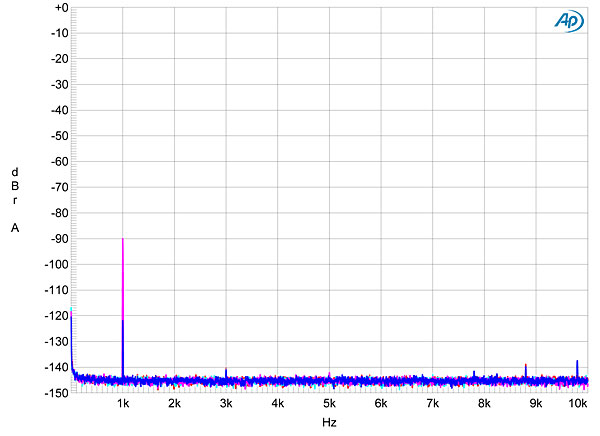
Fig.5 Bel Canto DAC3.5VB, FFT-derived spectrum with noise and spuriae of dithered 1kHz tones at –90dBFS (left channel cyan, right magenta) and –120dBFS (left blue, right, red). 24-bit data sourced from MacBook via Cardas USB cable, Bel Canto USB Link 24/96, and ST optical link.
Linearity error with 16-bit data was negligible below –110dBFS (not shown), but the DAC3.5VB didn't reproduce an undithered tone at exactly –90.31dBFS (fig.6) as cleanly as had the earlier DAC3. Increasing the bit depth to 24 gave a good if somewhat noisy representation of a sinewave (not shown); this surprised me, given the DAC3.5's superb low-level resolution shown earlier. Though the circuit still includes the Burr-Brown PCM1792 24-bit DAC chip used in the DAC3, the earlier model's Cirrus Logic CS8421 asynchronous sample-rate converter has been replaced by a Burr-Brown SRC4392 chip. I don't see why that should have made any difference to these measurements, but perhaps it is possible that jitter in the incoming datastream increases the level of random data in the output of the SRC chip. I don't know.
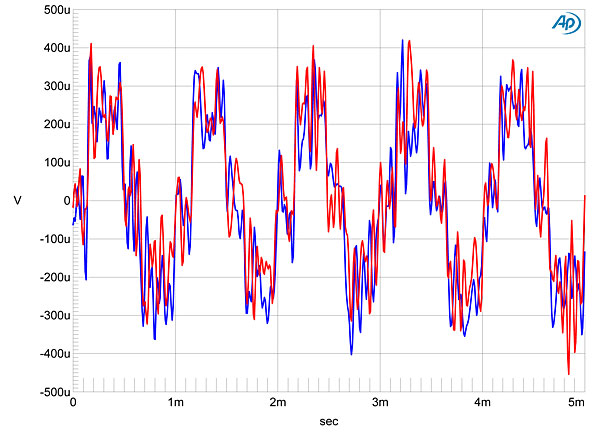
Fig.6 Bel Canto DAC3.5VB, waveform of undithered 1kHz sinewave at –90.31dBFS, 16-bit data (left channel blue, right red).
The Bel Canto's output stage, which appears to use high-quality OPA1632 differential-output op-amp chips, offers very low distortion even into very low impedances. Fig.7, for example, shows the spectrum of the DAC3.5VB's output while it drove a full-scale 50Hz tone into 600 ohms. While the second and third harmonics can be seen in both channels, these lie at –100 and –104dB, respectively. Some higher-order harmonics can be seen in the right channel (red trace), though these are even lower in level than the low-order harmonics. Intermodulation distortion was similarly vanishingly low (fig.8).
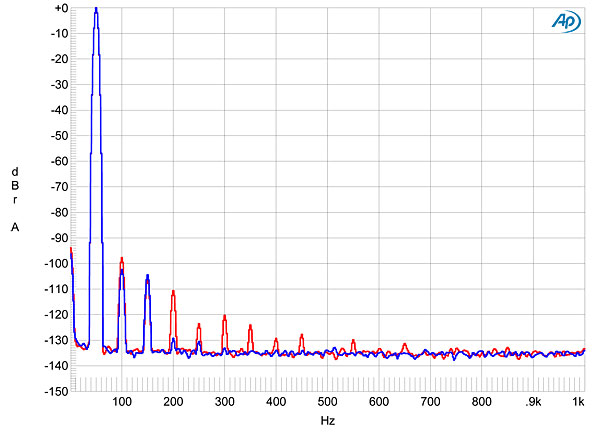
Fig.7 Bel Canto DAC3.5VB, spectrum of 50Hz sinewave, DC–1kHz, at 0dBFS into 600 ohms (left channel blue, right red; linear frequency scale).
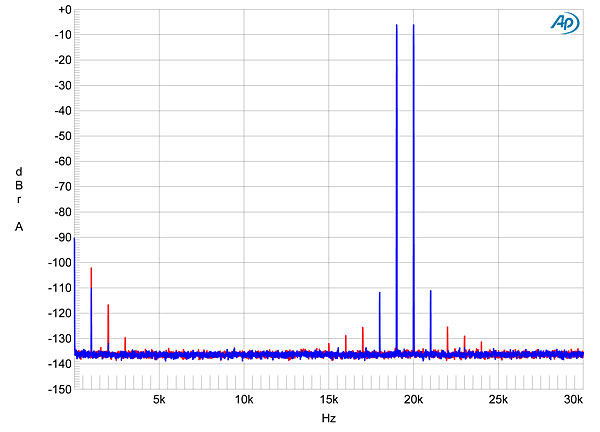
Fig.8 Bel Canto DAC3.5VB, HF intermodulation spectrum, DC–24kHz, 19+20kHz at 0dBFS into 100k ohms (left channel blue, right red; linear frequency scale).
When I originally tested the Bel Canto USB Link 24/96, in May 2009, its jitter rejection was not quite as low as I had wished. The ST-output version auditioned by Erick Lichte was much better in this respect, particularly when coupled with the DAC3.5VB. Fig.9 shows the spectrum of the DAC3.5's output while it was fed the 16-bit J-Test signal from my MacBook via the USB Link and an ST optical cable. The central spike is clean and well defined at its base, the sidebands are almost all at the residual level of the harmonics of the low-frequency squarewave, and the jitter level is below the resolution limit of my Miller Analyzer. The noisefloor is higher than I would have expected, however.
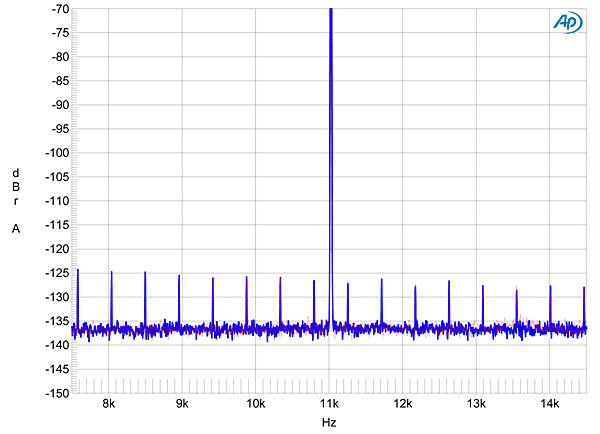
Fig.9 Bel Canto DAC3.5VB, high-resolution jitter spectrum of analog output signal, 11.025kHz at –6dBFS, sampled at 44.1kHz with LSB toggled at 229Hz: 16-bit data via USB from MacBook/USB Link 24/96/ST optical (left channel blue, right red). Center frequency of trace, 11.025kHz; frequency range, ±3.5kHz.
The spectrum of the DAC3.5VB's output remained as clean when I fed it the same 16-bit datastream via an AES/EBU link from the Audio Precision SYS2722 (fig.10, cyan and magenta traces), though now a single pair of low-level sidebands of unknown origin can be seen at ±92Hz. To my surprise, while changing to a 24-bit J-Test signal eliminated the odd-order squarewave harmonics (fig.10, blue and red traces), as anticipated, the noise floor remained at the 16-bit level. It looked as if some noise modulation was present, in that the level of the noise floor depended on the level of the signal.

Fig.10 Bel Canto DAC3.5VB, high-resolution jitter spectrum of analog output signal, 11.025kHz at –6dBFS, sampled at 44.1kHz with LSB toggled at 229Hz: 16-bit data via AES/EBU (left channel cyan, right magenta); 24-bit data via AES/EBU (left blue, right red). Center frequency of trace, 11.025kHz; frequency range, ±3.5kHz.
I investigated this by looking at the low-frequency spectrum of the Bel Canto's output while it decoded a 1kHz tone at 0dBFS (fig.11, top blue and red traces), at –40dBFS (middle cyan and magenta traces), and at –60dBFS (bottom blue and red traces). You can see that the level of the noise floor does depend on the signal level, with the drops in signal level from 0 to –40dBFS and from –40 to –60dBFS each lowering the overall noise floor by about 5dB. (Again, this behavior was not affected by low-pass filtering the signal.) This is very unusual; perhaps Bel Canto's design team have optimized the circuit's behavior to maximize low-level resolution, the tradeoff being very slightly higher noise levels with high-level signals. Or, as jitter has an increasing effect as the signal level rises, again perhaps it is possible that fig.11 is showing the effect of jitter on the behavior of the SRC chip.
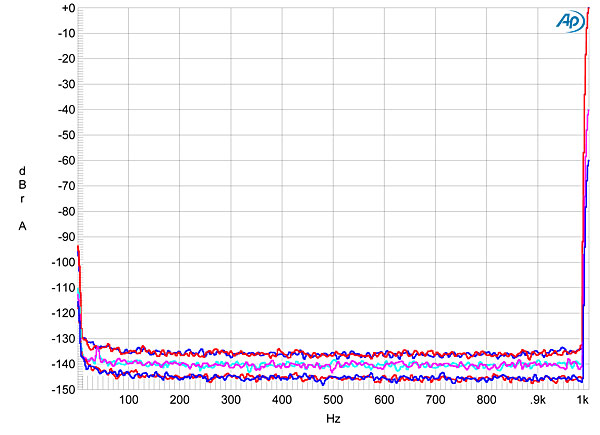
Fig.11 Bel Canto DAC3.5VB, spectrum of 1kHz sinewave, DC–1kHz, at: 0dBFS into 100k ohms (left channel blue, right red), –40dBFS (left cyan, right magenta), –60dBFS (left blue, right red). (Linear frequency scale.)
Although EL didn't use them, the DAC3.5VB has a pair of analog inputs that allow it to be used as a line preamplifier. The signal at these inputs is digitized at 192kHz with an AKM 5386 A/D converter chip, then fed to the DAC3.5VB's digital processor section. The analog inputs have an input impedance of 11.9k ohms at all frequencies, and the response is flat up to just below 96kHz, confirming that the ADC operates at 192kHz.
Bel Canto specifies this analog input as having a maximum input level of 2.5V. With a 1kHz tone at 2.5V, the THD+noise in the processor's analog output was 0.0045%. Increasing the input level to 2.63V increased the THD+N to 1%, suggesting that the A/D converter does output full-scale digital data just above 2.5V. Below that level, the ADC didn't seem to introduce any more distortion than the DAC3.5VB's D/A section. Fig.12, for example, shows the spectrum of the DAC3.5VB's output while it was fed an analog 1kHz tone at a level equivalent to –10dBFS. All the harmonics are very low in level. Repeating the test with an analog signal equivalent to a level of –90dBFS gave a spectrum (not shown) with the noise floor at around –140dBFS. This suggests that the AKM converter is operating with at least 18-bit true resolution, which is excellent performance.
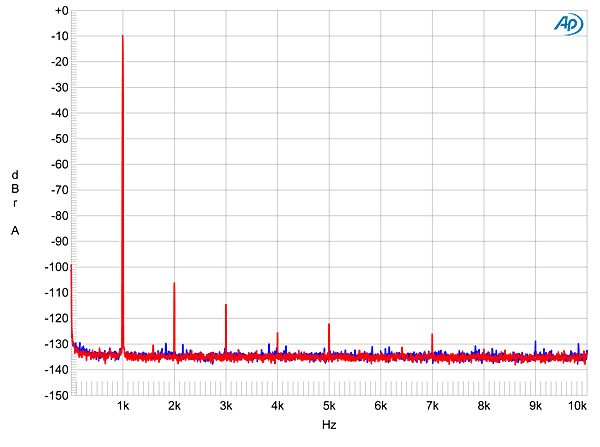
Fig.12 Bel Canto DAC3.5VB, analog input, spectrum of 1kHz sinewave, DC–10kHz, at –10dBFS into 100k ohms (left channel blue, right red; linear frequency scale).
Other than that noise-modulation issue, which I doubt will have audible consequences, Bel Canto's e.One DAC3.5VB offered superb measured performance with high resolution and low jitter.—John Atkinson
- Log in or register to post comments




































